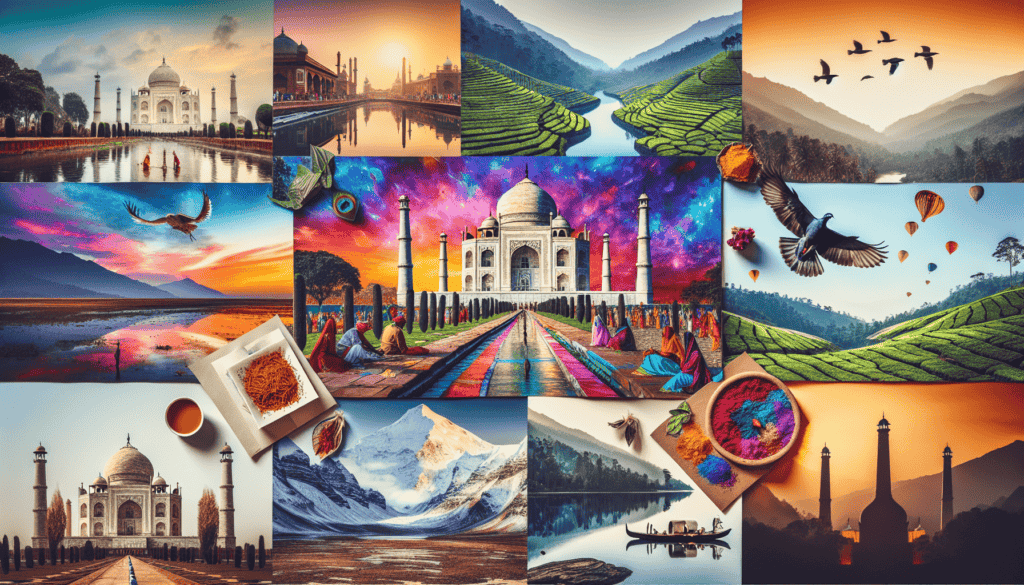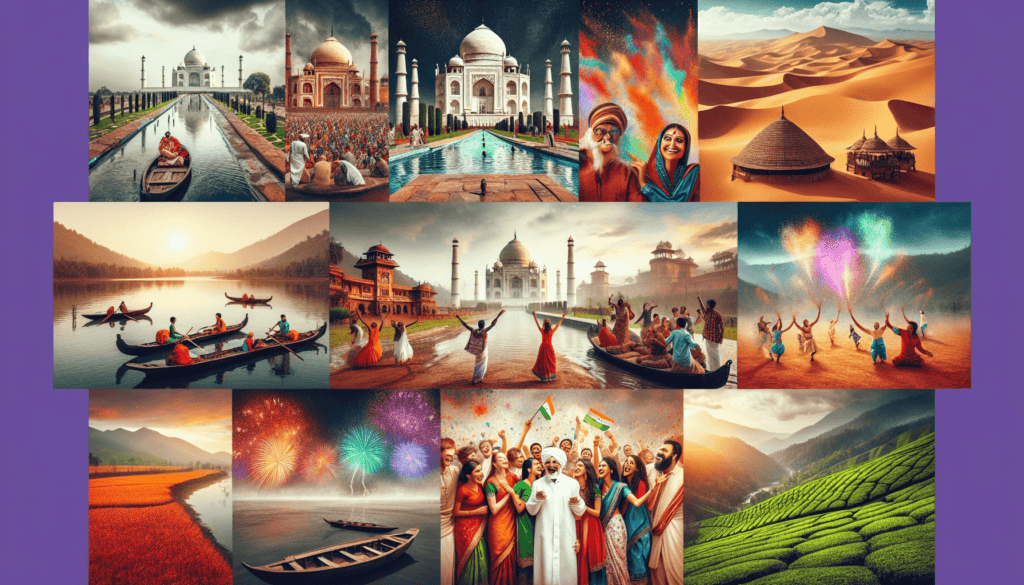Eager to pack your bags and venture on a thrilling journey? You’re in for a treat! Filled with the vivid hues of traditions, a myriad of alluring landscapes, and an eclectic mix of cultures; India is undoubtedly a treasure trove of experiences. Yet, the particular time of your visit can make a significant difference in your journey. “Explore The Best Time To Visit India: A Complete Guide” is your one-stop flight to unraveling not only the best seasons but also all the colorful festivals and unique local experiences that nestle within different corners of India throughout the year. Let’s chart out your itinerary!
Understanding India’s Climate
India is a richly diverse country, not only in its cultural heritage and traditions but also in its geography. From the serene beauty of the Himalayas in the north to the sandy beaches of the south; from the fertile plains of the east to the desert landscapes of the west, this country is home to a stunning array of geographic features. This diversity has a direct impact on its climate, leading to a large range of weather patterns across different regions.
Overview of India’s geographic diversity and its impact on climate
Each region in India has its own unique climate due to its geographic diversity. The north, graced with mighty Himalayan ranges experiences extreme cold during winters, while regions close to the equator including south and west coast are tropical and enjoy mild winter but hot summers. The central part experiences a blend of both extreme hot summers and cool winters.
How monsoon affects travel in India
Monsoon in India is not just a weather phenomenon, it is a season, it’s a mood, it’s an emotion. In June, the southwest monsoon winds bring heavy rainfall to the western coast and progressively move inland, affecting travel plans. Roads can be slippery, flights and trains may be delayed or cancelled, but monsoon also enhances the scenic beauty of nature, making some destinations more attractive.
Difference between weather in Northern and Southern India
While both northern and southern India experience the monsoon season, their weather patterns otherwise are quite different. Northern India has a more extreme climate with very hot summers and cold winters. In contrast, southern India has a tropical climate with hot summers and mild, pleasant winters.
Visiting India during Summer (April to June)
Summer in India is characterized by high temperatures, especially in the northern plains where temperatures can reach over 40 degrees Celsius. Despite the heat, summer invites tourists with the charm of the spectacular landscapes and vibrant festivals.
Advantages and disadvantages of visiting India during summer
The major advantage of visiting India during summer is fewer tourist crowds, leading to less crowded attractions and lower prices. However, the heat can be intense and may not be suitable for everyone, particularly in the northern and central parts of the country.
The best places to visit in India during summer
In the summer, the hill stations of north India such as Shimla, Manali, and Ladakh are great choices. In the south, Munnar and Ooty offer cool respite from the heat. These destinations offer cool climates and stunning landscapes that are a feast for the eyes.
Important festivals and events taking place in summer
Among the festivals that take place during the summer, the vibrant Holi festival, also known as the Festival of Colors, and Baisakhi, the Punjabi New Year, are particularly noteworthy.
Exploring India during the Monsoon Season(June to September)
Monsoons in India are a spectacle to behold. The rain-washed landscapes, the flourishing flora, and the invigorating air offer a unique charm to the country.
What to expect when traveling during the monsoon season
During monsoons, heavy rainfall can cause disruptions to travel plans. However, it also brings with it an aura of freshness. The fields look greener, the mountains look fresher, and waterfalls reach their full glory.
The effects of the monsoon season on travel plans
While the monsoon can lead to some changes in travel plans due to possible disruptions in transportation, it also offers an opportunity to witness the verdant landscapes and enjoy the rain-drenched beauty of places like Kerala, Goa, and Maharashtra.
Top destinations to visit in the monsoon
During monsoon, the hill stations of the Western Ghats are at their best. Kerala backwaters, Udaipur in Rajasthan, Lonavala in Maharashtra, and Coorg in Karnataka are ideal monsoon destinations.
Travel to India in Autumn (September to November)
Autumn in India comes with a mild and pleasant climate and is considered an excellent time to visit the country. The weather is ideal, neither too hot nor too cold.
Why autumn is an excellent time to visit India
The mellow weather of autumn provides the perfect environment for exploring the outdoor. The bright sun and crisp air make sightseeing and other activities a pleasure.
Stunning autumnal colors and landscapes to explore
Autumn brings an array of colors and India’s landscapes are transformed. This is a great time to visit the northeast states like Meghalaya or Sikkim which display a riot of colors during this season.
Festivals and events celebrated in autumn
Autumn time is festival time in India. Some of the most important Indian festivals like Navaratri, Dussehra, and Diwali are celebrated during this time with great pomp and show.
Winter Getaways in India (December to February)
Winter is a favored time to visit India. With a chill in the air, this is a perfect season to explore the sandy beaches of Goa or the snowy landscapes of the Himalayas.
Reasons why winter is a favored time to visit India
During winter, the weather is pleasant and comfortable for various activities like wildlife safaris, desert safaris, and trekking. Moreover, the winter season is full of festive merriment – you can partake in the Christmas and New Year celebrations in Goa or enjoy the colorful Pongal celebrations in Tamil Nadu.
Amazing winter destinations in India
Destinations like Rajasthan, Auli, Kerala, and Goa are popular winter spots. Rajasthan, with its forts and palaces, offers a trip back in time. Auli is a ski lover’s heaven, while Kerala and Goa offer a warm coastal respite from the cold weather.
Exploring India’s winter festivals and customs
Winter in India is a time of festivals and customs. In Rajasthan, the vibrant desert festival of Jaisalmer is a highlight. In Gujarat, the International Kite Festival fills the sky with myriad hues, while Pongal in Tamil Nadu celebrates the harvest season with delicious home-cooked food.
Spring in India (March to April)
Spring in India ushers in warm weather and is marked by the blossoming of beautiful flowers across the country.
Experiencing India’s incredible spring blooms
The temperatures in spring are moderate making it pleasant for sightseeing. You can visit the Valley of Flowers in Uttarakhand, famous for its myriad naturally occurring flower species.
Planning your Indian spring holiday
Cities like Shillong, Darjeeling, Gangtok, and Ooty are great spring destinations. These hill stations are not only a relief from the heat of the plains but also offer mesmerizing views and scenic charm.
Key festivals and traditions in Indian spring
Spring is also the season for colorful festivals like Holi, the festival of colors that marks the end of winter, and Baisakhi, which is celebrated as a harvest festival in Punjab.
Travel Guide for India’s Regions
India is known for its diverse regions, each with a unique climate, culture, and attractions. Planning your itinerary by region can allow you to experience the diverse landscapes and weather conditions of the country.
Guidelines for planning your itinerary by region
When planning your itinerary, remember that India is vast and attempting to visit all its regions in one trip can be overwhelming. Instead, focus on a select few areas for a more enriching experience.
Comparing the climates and attractions of India’s states
Each state in India offers something unique. For instance, Rajasthan offers a desert landscape with stunning forts and palaces, whereas Kerala provides a beach and backwater experience with lush green landscapes.
Top cities and tourist spots to explore by region
There are countless cities and tourist spots to explore across India. From the Taj Mahal in Agra, forts and palaces in Jaipur to the serene beaches in Goa and the unique waterways of Kerala, India has a lot to offer.
Health and Safety Concerns by Season
Traveling in India is generally safe, but it’s important to be conscious of the varying regional health concerns and safety guidelines, depending on the season.
Understanding regional health concerns
In the summer and monsoon seasons, there may be a risk of vector-borne diseases like dengue and malaria. Proper precautions such as using mosquito nets and repellents can help keep these at bay.
Preparing for different weather conditions
In the extreme summer heat, it’s important to stay hydrated. During monsoons, carry rain gear to stay dry and comfortable. Winter calls for warm clothing, especially in northern regions.
Keeping safe during India’s festival celebrations
Indian festival celebrations are exciting, but they can also be crowded. It’s important to keep an eye on your belongings and maintain personal safety in busy, crowded places.
Packing Guide for India’s Seasons
Knowing what to pack for an Indian vacation can be tricky due to the country’s varying climates, but here are some general guidelines based on the seasons.
Essential clothing items to pack
In summer, breathable fabrics like cotton are best. For monsoons, waterproof shoes and umbrellas are must-haves. For traveling in winter, you’ll need warm clothing like sweaters and jackets.
Preparing for India’s unpredictable weather
Given the unpredictable weather in India, it’s always a good idea to pack layers which can be added or removed as needed. Also, always have a hat, sunglasses, and sunscreen handy to protect from the sun.
Important travel gadgets and utilities to bring by season
Pack an umbrella for the monsoons, good quality sunglasses for the summer, and moisturizers and lip balms for the winter. A good camera is a must to capture the beauty of India in any season.
Tips and Reminders for Seasonal Travel in India
In a country as diverse as India, each season brings with it unique experiences, challenges, and delights.
Overcoming common challenges in India’s different seasons
Summer’s heat can be overwhelming; make sure to stay hydrated. Monsoons can bring unexpected travel disruptions; always have some flexibility in your travel plans. Winters can get quite chilly, especially in the North; bring appropriate clothing.
Practical advice for first-time visitors
India is vast and diverse, so don’t try to see everything in one visit. Consider focusing on a region or a specific interest, such as cultural heritage, wildlife or food.
Important reminders when participating in festivals and events
Indian festivals can be very crowded. Always ensure the safety of your personal belongings. Respect the cultural norms, and when unsure, don’t hesitate to ask the locals for guidance. Enjoy and immerse yourself in the vibrant culture and rich traditions that India has to offer.



